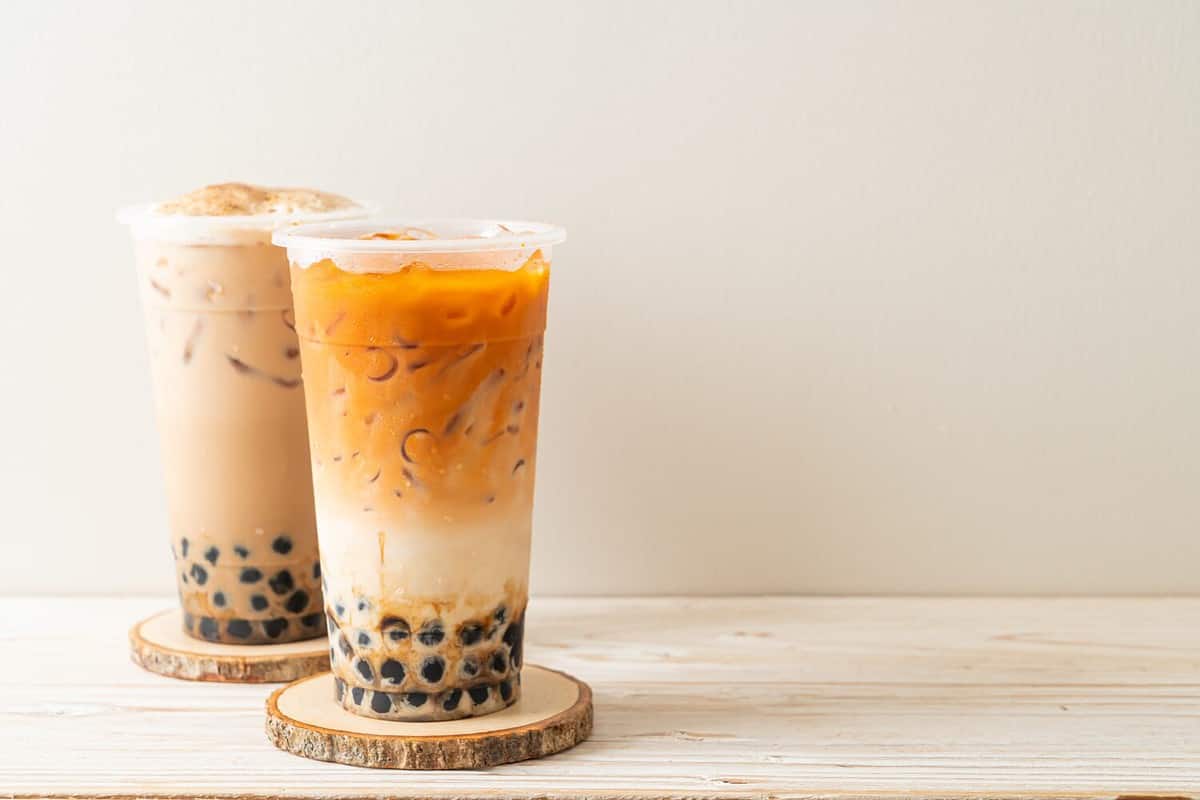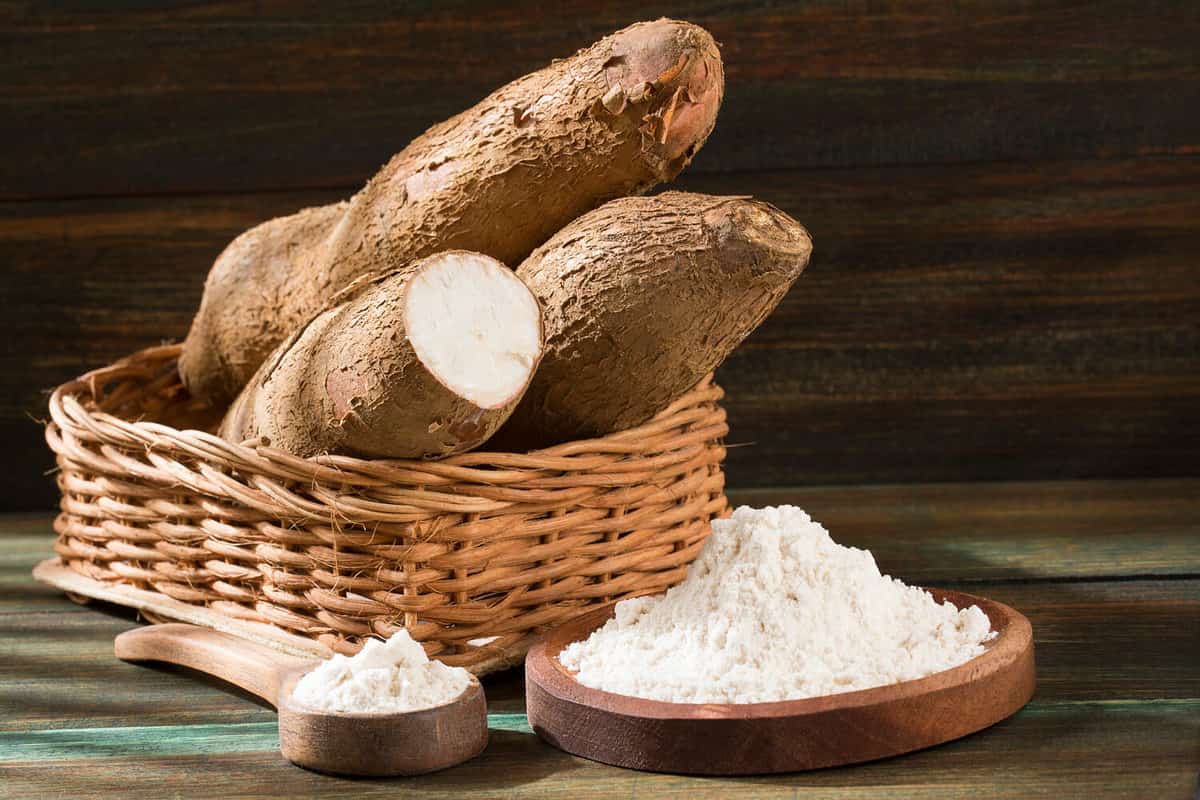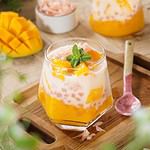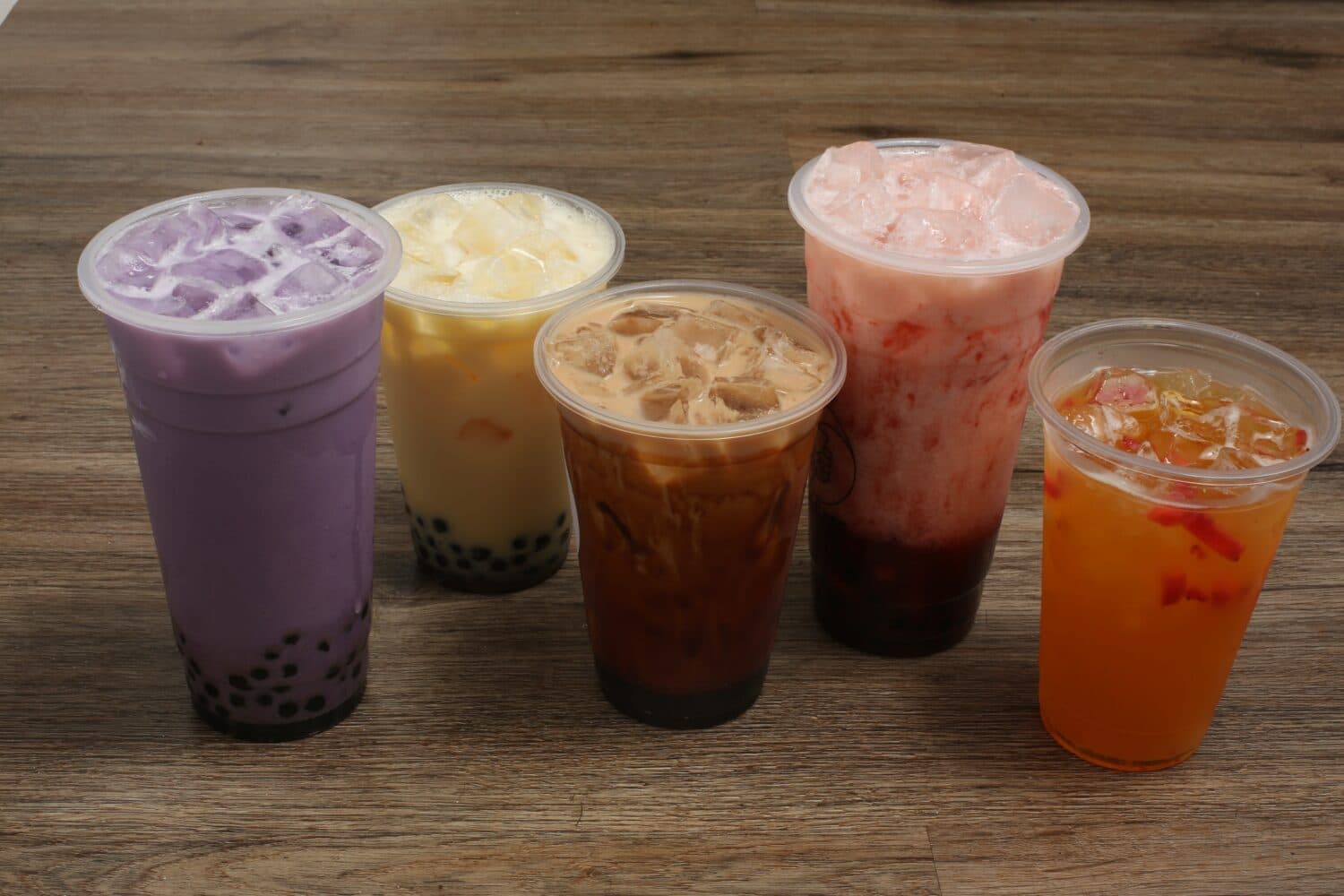In the early 1980s, boba tea, also known as pearl milk tea, tapioca milk tea, or bubble milk, was a well-known milk tea that came from Taiwan. It was introduced to the United States by Taiwanese immigrants who took it to California, notably Los Angeles. Later, the drink spread to other countries and became quite popular. Boba is a milk tea with added tapioca pearls, fruits, syrups, or jellies. However, many people have wondered if boba is healthy. In this article, we will dissect what boba is, its nutritional values, health benefits, and healthier alternatives.

©gowithstock/Shutterstock.com
What Is Boba Tea?
Boba teas are usually made with milk or without milk. As a base, to make boba green, black, or oolong tea is used. The typical milk added is usually fresh milk or powdered milk; however, other variants include coconut milk, almond milk, soy milk, and condensed milk. Additionally, hot black tea, condensed milk, honey or syrup, and tapioca pearls were the first known recipes to create boba tea. Today, it is commonly served cold with added ice.
Is Boba Healthy?
Boba on its own, has very few health benefits. Although it may provide you with a bit of energy, it is high in carbohydrates and calories, which could lead to weight gain and other possible health issues. Boba tea does contain a lot of sugar; high levels of sugar can lead to obesity, diabetes, heart disease, and tooth decay. According to the American Heart Association, consuming sugar is not necessary for our bodies to function. Sugar contains no nutrients and may lead to weight gain. It is advised that we should consume no more than 6% of sugar calories per day.
Although boba may be high in carbohydrates, there are benefits to tea itself. Let's take a closer look at the benefits of tea. Green tea and black tea are popular choices for boba tea drinkers. Researchers found that both teas can lower cholesterol, blood pressure, and breast, liver, and the incidence of prostate cancer. It also helps to lower the risk of stroke and heart disease because green tea is filled with beneficial antioxidants.
Healthy boba teas include:
- Fruit boba tea
- Roasted oolong milk
- Green boba tea
- Ginger lemon decaf boba tea
- Chia seed boba tea
- Macha boba tea

Boba Tea
- Total Time: 35 minutes
- Yield: 1-2 1x
Description
Try this quick and easy boba tea recipe.
Ingredients
- 200ml milk
- 2 tea bags of your choice
- 50g caster sugar
- Ice
- 50g quick cook tapioca balls
- 1 teaspoon dark brown sugar
For the syrup
- 50g dark brown sugar
Instructions
- First, allow the tea bags to brew for 10 – 15 minutes in 100 ml of boiling water. Throw the tea bags away and let the tea cool down to room temperature. For the clear sugar syrup, over medium heat, place the caster sugar in a small pot with 60 ml of water and bring it to a boil while stirring. Next, remove it from the heat and allow it to cool.
- In a small pot over medium heat, add 500 ml of water and bring it to a boil. Add the tapioca balls, stir, and make sure the balls do not stick to the side of the pan. Allow it to reach a rolling boil for 2 minutes, then turn off the heat. Put a lid on the pot and leave it on the stove for 2 minutes.
- Next, drain the balls into a sieve and run them under cold tap water until cooled. Use a spatula to mix the balls around so they do not stick together. Once cool to the touch, put them in a mixing bowl and add 1 teaspoon of dark brown sugar, then mix again.
- Using the same pan over medium heat, add 60 ml of water and 50 g of brown sugar to make the sugar syrup. It will make about 80 ml of syrup (2 ½ servings). Allow it to come to a boil and stir slowly until all the sugar has dissolved. Remove it from the heat; it will thicken as it cools down. If you have any leftover brown syrup, you can keep it in an airtight jar for a month.
- Now to put the tea together. If you are making two servings, put half of the balls into each glass. Or if you are making one large tea, place all the balls in a 500 ml glass. Next, to create a marble effect on the glass, whirl the balls around.
- Place the tea and 1 tablespoon of clear sugar syrup in the glass. Then add ½ cup of ice and stir gently, being careful not to remove the sticky marble effect from the glass. Add 200 ml of cold milk and serve with a thick straw. Enjoy!
- Prep Time: 35 minutes
- Cuisine: Taiwanese
Nutrition
- Serving Size: 250ml
- Calories: 550
- Sugar: 70g
- Sodium: 0.3g
- Fat: 7g
- Saturated Fat: 5g
- Carbohydrates: 115
- Fiber: 0.3g
- Protein: 7g
Tips To Create Boba Tea
- Adjust to your preferred sweetness.
- To reduce calories substitute sugar with light brown sugar, honey, monk fruit sweetener, yacon syrup, stevia, xylitol, or erythritol.
- Add the ice, tea, milk, and syrup to a shaker and shake for 10-15 seconds to create a foamy effect. Then, pour it into the syrup boba glass.
- To prevent cooked tapioca from hardening never put it in the fridge.
- Cooked balls only last for 3 hours, so it is best to only cook as much as you need.
- To save time use quick cook tapioca.
Nutritional Value of Boba
| According to Nutritionix | Serving Size: 16 fl oz (576g) |
|---|---|
| Calories | 278 |
| Total Fat | 0.6g |
| Saturated Fat | 0.4g |
| Polyunsaturated Fat | 0g |
| Monounsaturated Fat | 0.2g |
| Cholesterol | 2.5mg |
| Sodium | 19mg |
| Total Carbohydrates | 68g |
| Dietary Fiber | 0.5g |
| Sugars | 22g |
| Protein | 1.2g |
| Vitamin D | 0.3mcg |
| Calcium | 52mg |
| Iron | 0.9mg |
| Potassium | 105.4mg |
| Caffeine 47.5mg | 47.5mg |
What is Tapioca?
Tapica is manufactured by squeezing the starchy liquid out of the cassava root. Next, the water is left to vaporize leaving the tapioca powder behind, it is then made into flakes, flour, or pearls. The name boba tea is derived from tapioca pearls. These limped pearls are made from the starch of a cassava root and are approximately 0.2 to 0.4 inches (five to ten millimeters) in size.
Additionally, tapioca pearls come in different varieties — popping, black, clear, and flavored. This is because when sweeteners, water, and flavorings are added the pearls can have different textures and colors.
As mentioned it is also turned into flour, and flakes. Furthermore, to make them chewy and sweet they are drenched in a sugar syrup however, they are often added to tea for texture, and the tea alone contributes to flavor. Tapioca is also used as a thickening agent in pies and puddings.

©Luis Echeverri Urrea/Shutterstock.com
Health Benefits of Tapioca
One cup of tapioca has about 135g of carbohydrates and 550 calories. In addition, tapioca is a decent source of dietary fiber, iron, calcium, and manganese but it also has little sodium, cholesterol, and fat.
- Easy to digest: Some people have mentioned that tapioca is easier to digest than flour made from nuts or grains. It has been said by Medical News Today that there have been doctors who may recommend that those who have (IBS) irritable bowel syndrome could benefit from consuming tapioca.
- Calcium benefits: There are approximately 30mg of calcium in one cup of dry tapioca pearls. The body needs calcium to prevent osteoporosis and keep our teeth and bones healthy. However, 30mg per day is not enough the guidelines suggest 1,000 – 1,200mg of calcium per day. In addition, for those who enjoy drinking milk, 2-3 glasses per day would be the recommended daily allowance of calcium. Should you not be a fan of milk alone you can also consume yogurt, cheese, or other milk alternatives or take a supplement calcium tablet.
- Allergen-free: Those who are allergic to grain, gluten, and nuts may be happy to know that tapioca may be a decent addition to their dietary needs and for baking at home.
- May lower cholesterol: A study conducted in 2022 mentioned that a type of tapioca starch known as (TRM) tapioca-resistant maltodextrin may assist those who have high cholesterol.
- Good source of iron: There are 2.4mg of iron in one cup of tapioca pearls. Depending on sex and age the recommended daily value should be between 7-18mg. The body needs iron to carry oxygen to all parts of the body. Those with anemia usually lack iron in the blood.
Nutritional Facts of Tapioca Pearls
| According to the USDA | Serving Size: 100g |
|---|---|
| Calories | 358 |
| Total Fat | 0g |
| Saturated Fat | 0g |
| Cholesterol | 0g |
| Sodium | 1mg |
| Total Carbohydrates | 89g |
| Dietary Fiber | 0.9g |
| Granulated Sugars | 3.4g |
| Protein | 0.2g |
| Calcium | 2% |
| Vitamin B6 | 0% |
| Iron | 8% |
| Cobalamin | 0% |
| Vitamin C | 0% |
| Vitamin D | 0% |
| Magnesium | 0% |
Ways To Include Tapioca in Your Diet
Tapioca flour, pearls, and flakes can be used in a variety of recipes.
Here are a few ideas on how to include tapioca in your diet:
- Using tapioca pearls and coconut milk you can make a gluten-free vegan-friendly pudding.
- To thicken fruit pies, mix some tapioca starch into the pie filling ingredients.
- Add tapioca starch to cookies, loaves of bread, and muffins.
- Use green, or black tea to make boba tea.
- To make a Portuguese cheese bread use tapioca flour, milk, salt, cheese, oil, and eggs.
Try experimenting, you’d be surprised how many delicious tapioca recipes are out there.
Print
Mango Coconut Pudding with Tapioca Pearls
- Total Time: 15 minutes
- Yield: 4 1x
Description
This delightful, slightly sweet dessert is topped with chunks of juicy mangoes and takes only 15 minutes to prepare. It’s gluten- and dairy-free, and we know the whole family will enjoy it!
Ingredients
- 2 peeled and diced mangoes
- 3/4 cup of white tapioca pearls (sago)
- 3 tablespoons granulated sugar or honey
- 14 fluid ounces (1 can) coconut milk
- 5–6 cups of water
Instructions
- First, add the water to a large pot and bring it to a boil. Next, add the tapioca pearls.
- Cook on high for approximately 10 to 15 minutes, stirring often, until the pearls have a small white in the center.
- In the meantime, mix the sugar and coconut milk in a bowl until the sugar has dissolved. Put it in the fridge until needed.
- Strain the pearls once cooked, and then rinse them, under cold water until cooled. The pearls should look clear, and drain well.
- Add the pearls to the coconut milk and stir.
- Finally, pour the coconut pearls into your desired bowls or glasses and top with mango. Serve and enjoy!
- Tip: For a thicker pudding, allow the coconut pearls to sit in the fridge for 4 hours, then add the chopped mango when ready to serve.
Notes
- Polyunsaturated Fat: 3g
- Monounsaturated Fat: 1g
- Potassium: 8mg
- Vitamin A: 1119.9IU
- Vitamin C: 8mg
- Calcium: 1mg
- Iron: 3.6mg
- Prep Time: 5 minutes
- Cook Time: 10 minutes
- Cuisine: Taiwanese
Nutrition
- Calories: 393.8
- Sugar: 2g
- Sodium: 7mg
- Fat: 22.5g
- Saturated Fat: 19.7g
- Carbohydrates: 49.6g
- Fiber: 4g
- Protein: 2.9g
Final Thoughts
Finally, is boba healthy? While the pearls are not considered to be fully nutritional on their own, boba pearls can be part of a balanced diet when incorporated with other nutritional foods. Boba tea which uses tapioca pearls is low in sodium and can help you to monitor your blood pressure. It is easy to digest and can benefit those who have irritable bowel syndrome. However, boba tea can be high in sugar, so it is advised to choose healthier sugar alternatives as mentioned above. Tea on its own is high in antioxidants that benefit the body. Boba and other foods that are made with tapioca can be enjoyed in moderation, be mindful of your portion sizes so you can maintain a healthy balanced diet.
The image featured at the top of this post is ©Anabel Amour/Shutterstock.com.

